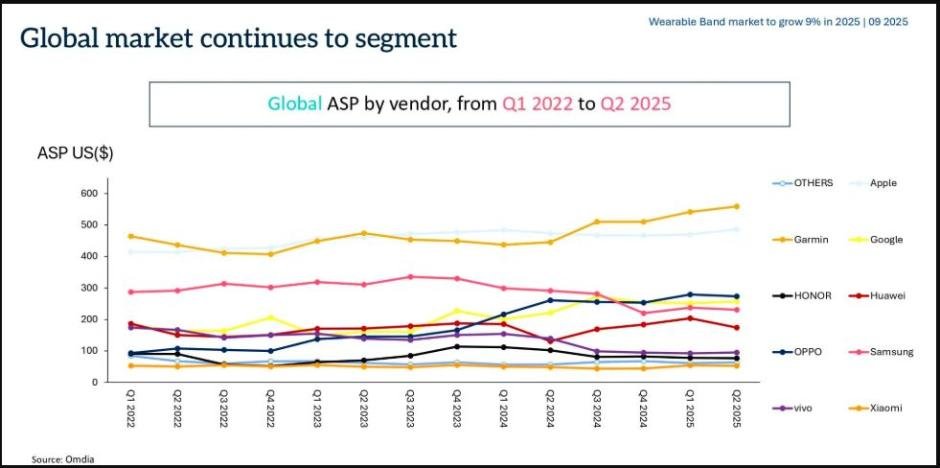The global wearable band market is on a powerful growth trajectory, reaching a valuation of US$36.6 billion in 2024 and set to exceed US$40 billion by the end of 2025, according to new Omdia research. Worldwide shipments climbed to a record 50.2 million units in Q2 2025, a 13 percent year-over-year increase, highlighting robust consumer demand and expanding use cases, according to Cynthia Chen, Omdia Research Manager.

Market Expansion Driven by Health and Fitness Focus
Omdia projects 8 percent market growth in 2025 and a further 9 percent rise in 2026, fueled by consumers’ heightened interest in health, fitness, and sports. Wearable bands have become an essential interface for wellness and medical apps, with smartwatches emerging as the key revenue driver, representing 69 percent of market value despite only accounting for 32 percent of unit shipments.
Key Growth Catalysts
Innovation & New Use Cases: Vendors are integrating advanced health tracking, medical applications, and 5G connectivity, making wearables indispensable for real-time monitoring and communication.
Subscription Opportunities: With nearly 500 million active users, companies are focusing on subscription services and connectivity plans to boost recurring revenue.
First-Time Buyers: Affordable basic bands continue to attract new users, especially in emerging markets, expanding the overall customer base.
Recent activities
Leading brands like Apple, Samsung, Xiaomi, Garmin, and Huawei are intensifying competition through feature-rich devices and ecosystem services.
Apple’s introduction of eSIM-only devices and 5G-enabled smartwatches exemplifies the shift toward stand-alone functionality and seamless digital subscriptions.
Apple has refreshed its smartwatch lineup in 2025, releasing the Watch Series 11, Watch Ultra 3, and Watch SE 3. The new SE 3 is notable as a stronger entry-level model, adding an always-on display, a faster S10 chip, gesture controls, and temperature tracking while keeping pricing lower than the premium models. Apple is also preparing to enter the smart glasses space, targeting a launch around end-2026, with work underway on power-efficient chips and designs to support cameras, microphones and AI/Siri interactions.
Samsung has been pushing into newer form-factors and expanding its health & AI capabilities. Its Galaxy Ring is a smart ring with health and fitness features, positioned alongside its Watch7 and Galaxy Watch Ultra models in its “Galaxy AI” wearables portfolio. The company is also rolling out Galaxy AI features across its devices, including upcoming Galaxy Watches, to deliver more motivational health insights through on-device AI. Samsung has also offered large discounts and promotions on its wearables (Watch8 series etc.), making its devices more accessible in certain markets.
Xiaomi has regained the lead in the global wearable band market in early 2025, particularly Q1, overtaking Apple. Its shipment growth has been very strong (about 44% YoY in Q1) driven by value-oriented, budget to mid-tier devices like the Smart Band series and Redmi Band. They have also emphasized integration through their HyperOS platform and improved design and features in their lower-cost models. New releases include Watch S4 and Smart Band 10 Glimmer Edition in certain regions.
Garmin has introduced the Garmin Connect+ subscription service, adding premium features such as AI-based insights, expanded coaching and training tools, live activity metrics, etc. That move has met with mixed to negative reaction from parts of its user base, especially those who feel features that used to be free are moving behind paywalls. Also, Garrett has launched new hardware like the Venu 4, with upgraded display, health-tracking improvements, enhanced sleep metrics, and a rugged design.
Huawei has continued investing in health-sensor tech and premium watch hardware. They introduced their TruSense system which promises improvements in accuracy, especially across various skin tones, wrist sizes, and conditions. More recently, they released the Watch GT 6 and GT 6 Pro models, with stronger battery life (21 days in light usage), brighter AMOLED displays, new sensors for cardiovascular and health analysis (TruSense), plus premium materials (titanium, sapphire, ceramic) especially in the Pro version.
Market share
Xiaomi led the market with 9.5 million shipments and an 18.9 percent share, up from 5.9 million units and 13.3 percent in Q2 2024. Huawei followed with 8.8 million shipments and a 17.4 percent share, rising from 6.0 million units and 13.5 percent a year ago. Apple shipped 7.6 million units for a 15.2 percent share, slightly down from 7.7 million and 17.4 percent previously.
Samsung increased shipments to 4.3 million and an 8.6 percent share from 2.8 million and 6.4 percent a year earlier. Noise shipped 2.0 million units, capturing 4.0 percent share versus 2.4 million and 5.4 percent in Q2 2024. The “Others” category shipped 18 million units for a 35.9 percent share, declining from 19.5 million and 44.1 percent a year before, reflecting stronger performance among the leading brands.
Outlook
With strong consumer appetite and technological advancements, the global wearable band market is poised to maintain a solid upward trajectory, surpassing the US$40 billion milestone in 2025 and continuing to grow steadily toward 2030. Vendors focusing on health-centric features, recurring revenue streams, and customer engagement will be best positioned to capture this expanding market.
Baburajan Kizhakedath
